What is Sexuality Counseling?

Dr. Autumn Dae Miller discusses the importance of sexuality counseling and sthe five circles of sexuality.
By Sydney Kerelo
On the first day of kindergarten, a little boy sits at his desk, coloring pictures and cutting shapes. While he struggles with cutting, a teacher’s aide takes note, coming over to assist. She leans over, pressing her entire front into that child’s back, breaking his consent to be touched and a boundary. That is just one of the many situations that KenCrest’s Director of Behavioral Health, Dr. Autumn Dae Miller, handles daily.
“We must teach kids from a very early age about boundaries and consent, not just for themselves, but for other people,” says Dr. Miller. “If you’re going to start having a conversation about sexual safety and awareness, you have the simplistic action of offering kid boundaries and consent.”
But how can we teach young children about boundaries and consent? How can we teach that to people with disabilities? And what exactly is sexuality counseling?

Sexuality is self-defined and used to discuss how we understand our bodies. It helps us understand our relationships and allows each person to understand sexuality in their way. It is ever-changing and unique to each person.
“The standard concept of what sexuality is, comes from an all-encompassing, comprehensive model of sexuality,” says Dr. Miller. “This is called the circle of sexuality and was created in the 80s. Think of sexuality as five concentric circles (sexualization, sensuality, intimacy, sexual health, and reproduction and sexual identity); these circles identify your sexual values and makeup who you are as a person.”
Each circle is unique and addresses a different concern, whether about sexual orientation, sex education or even the physiological and psychological needs of one’s body image.
The first circle, sensuality, talks about the element of touch and fantasy. Sensuality allows people to understand the differences between fantasizing about someone sexually and the reality of the situation.
“Our folks [supported through I/DD services] sometimes have the hardest time with imagination because people constantly tell them what to do, when to wake up, what to eat, when to eat, where to go, etc.,” says Dr. Miller. “Nobody even asks them questions, from very early on in their age they don’t get choices and therefore have trouble developing a sense of imagination and creativity.”
So, this circle breaks down feelings of physical attraction for another person, fantasy, and understanding of the importance of a person’s body image. Many of the people KenCrest supports to reach out to Dr. Miller because they don’t like the way they look or their body doesn’t function the way it’s “supposed to,” and Dr. Miller works with them to reframe what beauty is—showing them that they are beautiful and worth dating.
RELATED: Invest in Inclusion with KenCrest
The second circle is about sexualization, which is the manipulation and control elements, and it usually deals with people who have past experiences with sexual abuse, incest, rape, and violence. But it also encompasses seduction and flirting, positive elements of sexualization. Dr. Miller teaches those within this circle about understanding consent and how if one person feels attracted to another, it doesn’t always mean the other person feels the same.
“There’s a cyber element we teach within that sexualization circle, too,” says Dr. Miller. “The people we support, and our agency are moving toward enabling technology. With that comes educating the people we support about good boundaries and understanding that you can’t search every single term in the world safely, and you must be clear about what you’re searching for and why.”
The third circle is sexual identity, which includes sexual orientation, gender identity, and gender roles. There are many people KenCrest supports who have transitioned or have become comfortable being nonbinary.

According to Dr. Miller, KenCrest has a few people who are non-verbal and unable to identify their sexual identity. “This one person that we work with, we approach him every single day and ask, ‘are you having a mommy day or a daddy day?’ and he can choose who he wants to be whatever day he feels like it.”
Intimacy is the fourth circle, which revolves around liking, loving, caring, sharing, risk-taking, vulnerability, and all the experiences of relationships. It’s the need to be close to another human being and have that need returned. Intimacy focuses on the emotional closeness, attachments, and connections between two people.
“The fifth circle is sexual health and reproduction, where the people we support learn about contraceptives and safe sex practices, not just physical safety but emotional safety,” says Dr. Miller. “Most of our students come from a structure where they were in social skills classrooms all the time, and they’re almost always not around peers enough or socialized enough to build communication around sexuality.
Each circle identifies a different concern regarding sexuality and helps teach the people we support about their bodies, relationships, and sexual orientations that they may not know about otherwise.
